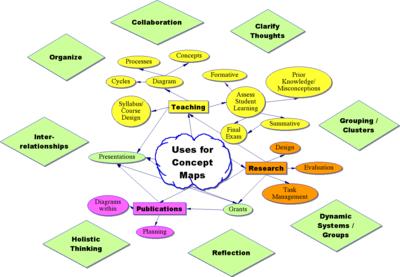WHAT ARE CONCEPT MAPS?
Concept Maps (cmaps) are organized graphical representations of concepts, symbols and connections put together in such a way as to demonstrate relationships and acquired knowledge. They are different from webbing because they contain "cross-links" that connect two or more seemingly unconnected concepts or ideas together with linking words. Imagine a tree with branches and following along the trunk, out a branch and to the leaf, this is a webbing model. Now imagine that same path but the leaf is touching another leaf - could be one close by or on the other side of the tree. Makes for a strange-looking tree, but as a concept map, demonstrates deeper understanding, cognitive function and even a little creativity.

USES FOR CONCEPT MAPS:
Analogy: Conceptual maps are to pedagogy is as duct tape is to a handy person. In other words, they have many definitions and even more potential uses. Here are just a few uses:
o an instructional tool (visualizations, identifying misconceptions, formative & summative assessments, student groupings / cooperative learning) / project management),
o organizational tool for students (project, paper, reading reflection, study guide, metacognitionŠ),
o organizational tool for faculty (article, grant or research proposal), course/syllabus planner,
o any other way that meets your course outcomes!
If you have used concept maps in your course, let us know! Email Carrie with a brief description so we can supplement our general uses above with specific uses at BGSU. To Learn More, See These Concept Map Links:
Go to
CMAP HOME for a comprehensive set of resources and materials.
An exerpt from a manuscript describing Concept Mapping by the original developer and creator,
J.D. Novak.
My favorite cmap on the web:
Saint Nicolas!This site has a nice graphic and gives some
basic, clear instructions about creating a concept map.
This is an excellent, clear
guide to cmap creation.
This instructional and handy site is about using
cmaps in assessment that is heavily referenced by other sites.
This pdf is a study done about
student cmapping assessment. Reading it provides you with some of the theory behind cmapping, and tables comparing assessment purposes and assessment frameworks.
